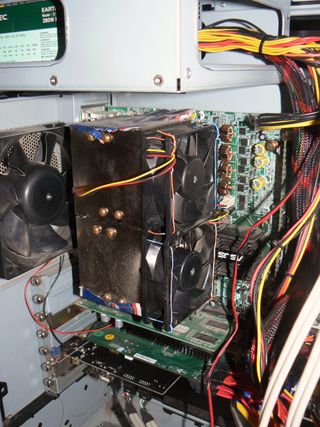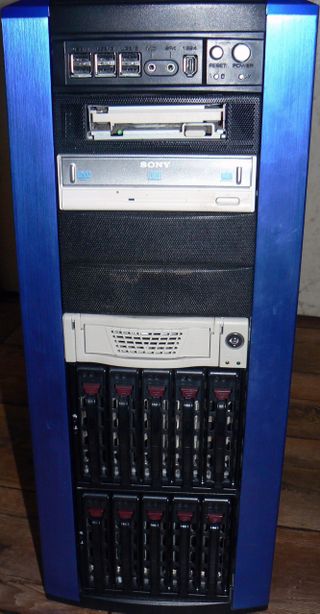Reader's Voice: Building Your Own File Server
CPU, Power, And Costs

You don't need a super-fast CPU for a file server. However, it can be a good idea to have more than one processor. A single CPU can be kept busy doing parity calculations (needed for RAID 5), but if you decide to use RAID 6, there will be more parity calculations and you will need more CPU cycles.
My first file server sports dual Pentium III 933 MHz processors. I can see 100% CPU usage during RAID array rebuilding, so I recommend something faster. My second file server uses dual Xeon 2.8 GHz CPUs with Hyper-Threading, and I have never seen both cores at 100% CPU usage.
A 2 GHz dual-core AMD processor will probably be sufficient. Of course, newer processors tend to be more efficient, so if you are going with a more modern platform, you'll likely save energy as you enable better performance.
If I were buying a new processor for a file server today, I would pick a slow, cheap AMD Phenom II. The reason is they can be had inexpensively, the motherboards for them are priced reasonably, they run cool, and the chipsets for the motherboards generally support ECC and Chipkill.

UPS
No matter what hardware you buy, you should have a UPS to deal with power failures. You can get by with a cheap one, but a higher-quality unit will likely pay off in the long term. At a minimum, you will want to be able to shut down your file server in an orderly fashion should the power go out, which means a minimum of three to five minutes of power. Another nice feature of most UPSes is that they have a built-in surge protector.
Hardware Costs
Stay on the Cutting Edge
Join the experts who read Tom's Hardware for the inside track on enthusiast PC tech news — and have for over 25 years. We'll send breaking news and in-depth reviews of CPUs, GPUs, AI, maker hardware and more straight to your inbox.
Obviously, there can be a wide range of costs in building a file server depending on how much storage you want and what hardware you already own. Here are some typical costs and options:
- Case: $150 for a case similar to my Cooler Master Stacker 810. Look for the ability to hold lots of disks
- Power Supply: $50 for a 350 W or so 80 PLUS power supply
- Disks: six 1 TB disks, roughly $80 each
- Operating Drive: Free, assuming you can find a 10 GB drive lying around
- DVD Drive: $20
- Motherboard: $100 is plenty for a dual-Opteron motherboard with 2-4 GB of ECC memory, assuming you don’t have some spare hardware. You could start with a dual Pentium III motherboard, which is cheaper than dirt. I happen to have several gathering dust. Expect to pay $150 for a new motherboard with a warranty
- Memory: $50
- CPU: $100
- SATA Controller Card: $100
The total cost is roughly $420-$620, plus $540 for the hard drives. This will make a 5 TB RAID 5 file server that can easily be expanded to eight or more drives. If you are building your own, I suspect you will have a fair number of the parts already lying around. This is cheaper than most NAS boxes that hold four or five disks and will be faster and far more flexible.
-
wuzy Yet again why is this article written so unprofessionally? (by an author I've never heard of) Any given facts or numbers are just so vague! It's vague because the author has no real technical knowledge behind this article and are basing mainly on experience instead. That is not good journalism for tech sites.Reply
When I meant by experience, I didn't mean by self-learning. I meant developing your own ideas and not doing extensive research on every technical aspects for the specific purpose. -
wuzy And even if this is just a "Reader's Voice" I'd expect a minimum standard to be set by BoM on articles they publish to their website.Reply
Most IT professionals I have come to recognise in the Storage forum (including myself) can write a far higher caliber article than this. -
motionridr8 FreeNAS? Runs FreeBSD. Supports RAID. Includes tons of other features that yes, you can get working in a Linux build, but these all work with just the click of a box in the sleek web interface. Features include iTunes DAAP server, SMB Shares, AFP shares, FTP, SSH, UPnP Server, Rsync, Power Daemon just to name some. Installs on a 64MB usb stick. Mine has been running 24/7 for over a year with not a single problem. Designed to work with legacy or new hardware. I cant reccommend anything else. www.freenas.orgReply -
bravesirrobin I've been thinking on and off about building my own NAS for around a year now. While this article is a decent overview of how Jeff builds his NAS's, I also find it dancing with vagueness as I'm trying to narrow my parts search. Are you really suggesting we use PCI-X server motherboards? Why? (Besides the fact that their bandwidth is separate from normal PCI lanes.) PCI Express has that same upside, and is much more available in a common motherboard.Reply
You explain the basic difference between fakeRAID and "read RAID" adequately, but why should I purchase a controller card at all? Motherboards have about six SATA ports, which is enough for your rig on page five. Since your builds are dual-CPU server machines to handle parity and RAID building, am I to assume you're not using a "real RAID" card that does the XOR calculations sans CPU? (HBA = Host Bus Adapter?)
Also, why must your RAID cards support JBOD? You seem to prefer a RAID 5/6 setup. You lost me COMPLETELY there, unless you want to JBOD your OS disk and have the rest in a RAID? In that case, can't you just plug your OS disk into a motherboard SATA port and the rest of the drives into the controller?
And about the CPU: do I really need two of them? You advise "a slow, cheap Phenom II", yet the entire story praises a board hosting two CPUs. Do I need one or two of these Phenoms -- isn't a nice quad core better than two separate dual core chips in terms of price and heat? What if I used a real RAID card to offload the calculations? Then I could use just one dual core chip, right? Or even a nice Conroe-L or Athlon single core?
Finally, no mention of the FreeNAS operating system? I've heard about installing that on a CF reader so I wouldn't need an extra hard drive to store the OS. Is that better/worse than using "any recent Linux" distro? I'm no Linux genius so I was hoping an OS that's tailored to hosting a NAS would help me out instead of learning how to bend a full blown Linux OS to serve my NAS needs. This article didn't really answer any of my first-build NAS questions. :(
Thanks for the tip about ECC memory, though. I'll do some price comparisons with those modules. -
ionoxx I find tat there is really no need for dual core processors in a file server. As long as you have a raid card capable of making it's own XOR calculations for the parity, all you need is the most energy efficient processor available. My file server at home is running a single core Intel Celeron 420 and I have 5 WD7500AAKS drives plugged to a HighPoint RocketRAID 2320. I copy over my gigabit network at speeds of up to 65MB/s. Idle, my power consumption is 105W and I can't imagine load being much higher. Though i have to say, my celeron barely makes the cut. The CPU usage goes up to 70% while there are network transfers, and my switch doesn't support jumbo frames.Reply -
raptor550 Ummm... I appreciate the article but it might be more useful if it were written by someone with more practical and technical knowledge, no offense. I agree with wuzy and brave.Reply
Seriously, what is this talk about PCI-X and ECC? PCI-X is rare and outdated and ECC is useless and expensive. And dual CPU is not an option, remember electricity gets expensive when your talking 24x7. Get a cheap low power CPU with a full featured board and 6 HDDs and your good to go for much cheaper.
Also your servers are embarrassing. -
icepick314 Have anyone tried NAS software such as FreeNAS?Reply
And I'm worried about RAID 5/6 becoming obsolete because the size of hard drive is becoming so large that error correction is almost impossible to recover when one of the hard drive dies, especially 1 TB sized ones...
I've heard RAID 10 is a must in times of 1-2 TB hard drives are becoming more frequent...
also can you write pro vs con on the slower 1.5-2 TB eco-friendly hard drives that are becoming popular due to low power consumption and heat generation?
Thanks for the great beginner's guide to building your own file server... -
icepick314 Also what is the pro vs con in using motherboard's own RAID controller and using dedicated RAID controller card in single or multi-core processors or even multiple CPU?Reply
Most decent motherboards have RAID support built in but I think most are just RAID 5, 6 or JBOD.... -
Lans I like the fact the topic is being brought up and discussed but I seriously think the article needs to be expanded and cover a lot more details/alternative setup.Reply
For a long time I had a hardware raid-5 with 4 disk (PCI-X) on dual Athlon MP 1.2 ghz with 2 GB of ECC RAM (Tyan board, forgot exactly model). With hardware raid-5, I don't think you need such powerful CPUs. If I recalled, the raid controller cost about as much as 4x pretty cheap drives (smaller drives since I was doing raid and didn't need THAT much space, it at most 50% for the life of the server, also wanted to limit cost a bit).
Then I decided all I really needed was a Pentium 3 with just 1 large disk (less reliable but good enough for what I needed).
For past year or so, I have not had a fileserver up but planning to rebuild a very low powered one. I was eyeing the Sheeva Plug kind of thing. Or may be even a wireless router with usb storage support (Asus has a few models like that).
Just to show how wide this topic is... :-)
Most Popular

